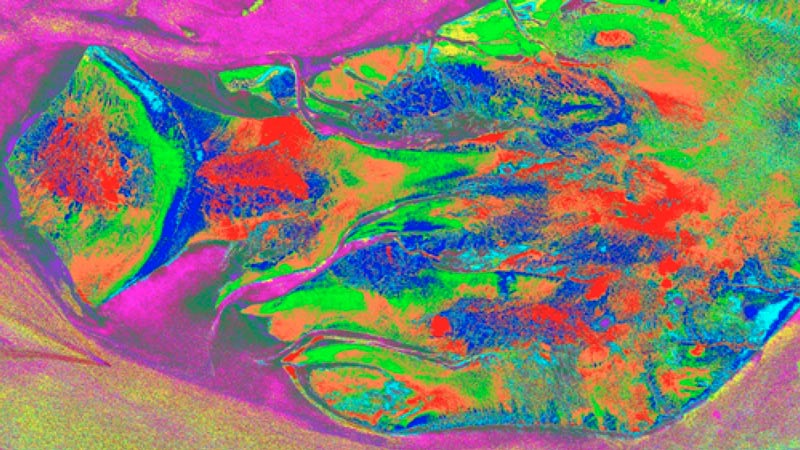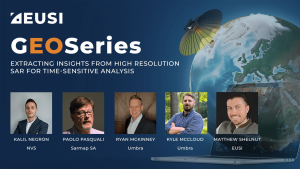Protecting the Dutch Coast With Satellites
- European Space Imaging
Digital Surface Models (DSM) are key components for urban planning, biomass estimation and many more. With nearly 50 percent of its landmass lying at or below sea level, the Netherlands lives up to the name “Low Country”. Bordered on the north and west by the North Sea, protecting the coastline from flooding is a top priority. With climate change and other human and environmental factors influencing sea levels, the Dutch government recently launched an extensive coastal protection initiative using satellite imagery to monitor coastal change.
A crucial natural flood barrier
Stretching from the Netherlands through Germany and north to Denmark, the 10,000 square kilometer Wadden Sea is crucial to the protection of the Dutch coast from North Sea flooding. A UNESCO World Heritage Site, the Wadden Sea is a shallow body of water with extensive tidal flats and wetlands and rich in biodiversity important to protecting the coast from flooding.
“An enormous amount of water is filtered through mussel and oyster beds, which help reduce the energy of waves thereby making them a natural flood barrier,” explains Norbert Dankers, Estuarine ecologist, Coastal zone management specialist, Institute for Marine Resources and Ecosystem Studies (IMARES).
“Our objective was to better monitor and protect mussel beds which in turn would act as a coastal defense mechanism,” Johan Stapel, Marine biologist, IMARES.

Mapping the Wadden Sea using regularly updated very high resolution satellite imagery enables changes to be detected early, over a very large area.
High-resolution imagery critical to project goals
Remote sensing has been used as a monitoring tool in the Wadden Sea for more than 30 years. Early projects, validated with ground measurements on intertidal sediment composition, classified different sediment types, but did not provide a viable solution for ongoing long-term change detection.
“Our objective is to develop an ongoing, cost-effective methodology focused on sediment classification, identification of mussel and oyster beds, intertidal areas, coastline, gullies and channels and the detection of temporal and spatial changes,” Narangerel Davaasuren, MSc environmental sciences and remote sensing IMARES explains. “The ready availability of cost-effective, high-resolution satellite imagery provided by European Space Imaging gives us the opportunity to put in place the tools and procedures to develop viable coastal defense applications.”
WorldView-2 proves to be an indispensable tool
Protecting the Dutch coastline from flooding is a multipronged effort. An elaborate system of dikes, dams, channels and seawalls has long been in place. But with climate change and other human and environmental factors influencing sea levels, the need to protect the coastline has never been greater, giving new importance to the Wadden Sea mussel and oyster beds.
“Classifying the beds poses a number of unique challenges,” Davaasuren explains. “For example, there are many weather challenges to overcome and we need to collect the images at low tide, which helps expose sediment levels. The global coverage of high-resolution satellites like WorldView-2, with its daily revisiting and relatively low cost, makes this technology especially attractive from both an economic and research standpoint.”
A long term change detection solution
Sustainable data provision is crucial to ensuring a cost-effective and functional monitoring solution into the future. Data collection must be based on tides and seasons in order to monitor seasonal changes. Working closely with European Space Imaging to procure imagery, IMARES is confident the WorldView-2 data in combination with historic data, will provide the foundation for a strong decision-making tool moving forward.
"The high-resolution WorldView-2 images allow us to detect possible negative gully developments along the coast of Schiermonnikoog and Rottum Islands, two areas we targeted for study. In addition, the changes in the salt marshes in the northwestern part of the country are also clearly visible. Our study concluded that high-resolution WorldView-2 imagery is an indispensable tool in monitoring and change detection for coastal defense applications."
NARANGEREL DAVAASUREN, Marine Resources & Ecosystem Studies, Wageningen University
Challenge
Develop an ongoing solution to identify, classify, and monitor change to the mussel and oyster beds of the Wadden Sea in the Netherlands, a natural flood protection barrier from the North Sea.
Solution
With daily revisiting and relatively low-cost, WorldView-2 highresolution imagery created the foundation for coastal defense applications.
Results
WorldView-2 imagery from European Space Imaging is providing IMARES with timely, cost effective and highly accurate data to monitor changes to the whole environment in a the Wadden Sea.
ABOUT IMARES
The Institute for Marine Resources & Ecosystem Studies (IMARES) at Wageningen University in the Netherlands is an independent, objective and authoritative institute that provides the knowledge necessary for an integrated sustainable protection, exploitation and spatial use of the sea and coastal zones.
Related Stories

GEOSeries: Extracting Insights From High Resolution SAR Imagery for Time-Sensitive Analysis
In this webinar, industry experts and advanced users of Umbra SAR data showcase how they transform SAR imagery into actionable insights in real-world mapping, monitoring and intelligence applications. See how NV5 and Umbra leverage ENVI SAR Essentials for advanced processing with time-efficient results, converting analytics into valuable intelligence.

Using Satellite Imagery to Build Water Resilience Across Europe
Water across Europe is facing severe pressure. Climate change, urbanisation, agricultural demands and other sources of pollution are threatening water security and creating critical challenges that need to be addressed. We have to act quickly, build stronger systems and create sustainable water resilience practices – so that both natural ecosystems and human communities can thrive. Here is how satellite imagery from EUSI can help.

EUSI and Albedo Partner to Deliver 10 cm Resolution Satellite Imagery to Europe
It is our pleasure to announce the partnership with Albedo, a builder of high-performance spacecraft and the first satellite designed to operate commercially in VLEO (Very Low Earth Orbit). This partnership will bring the world’s highest resolution satellite imagery to the European and North African market.

Updating the Land Parcel Identification Systems in 2025: The Benefits of Using Satellite Images
Agricultural paying agencies across Europe face increasing challenges in maintaining accurate and up-to-date Land Parcel Identification Systems (LPIS), ensuring compliance with the Common Agricultural Policy (CAP) and supporting sustainable agricultural practices.





